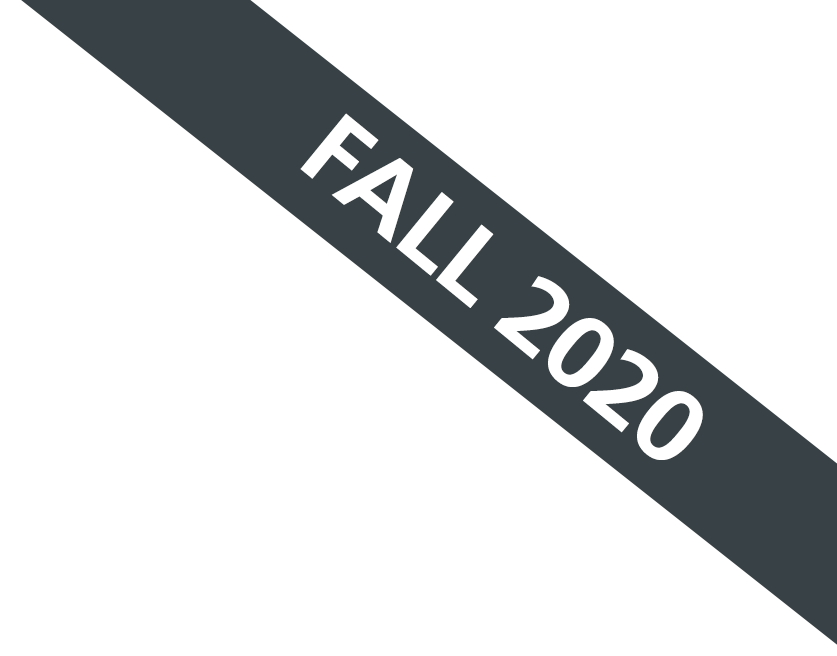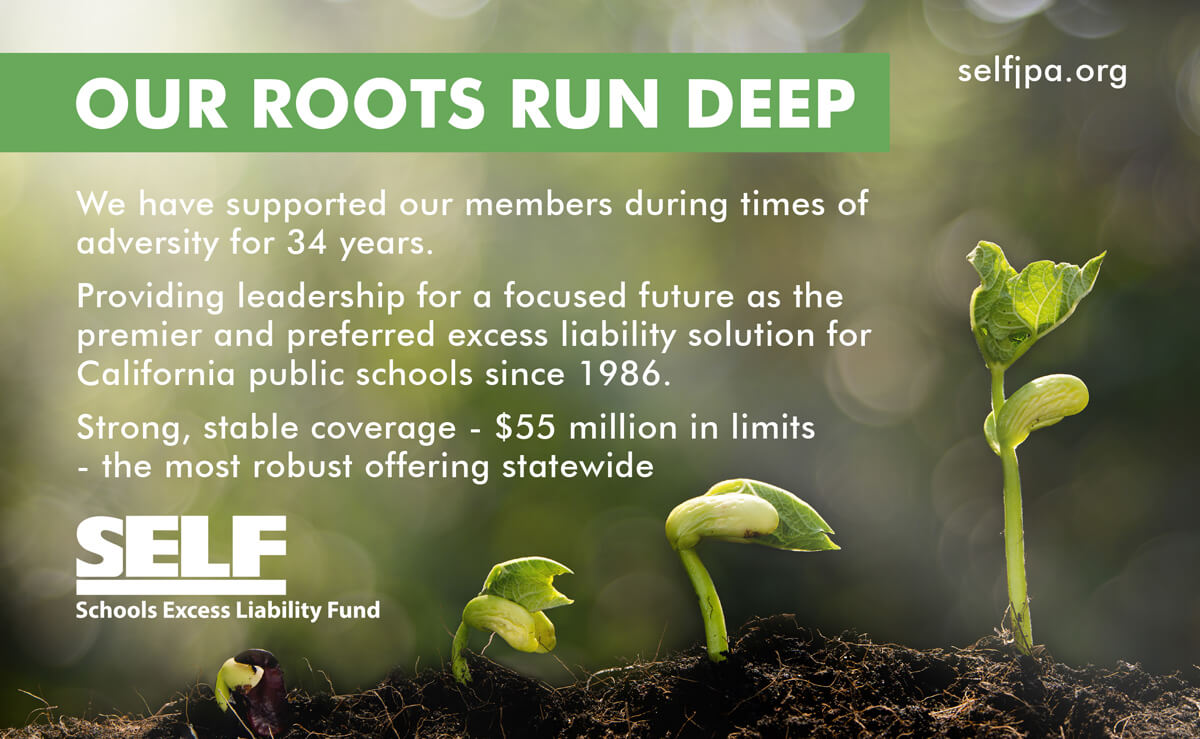
Fall 2020
Insights into a back-to-school process for the history books
by Andrew Cummins
by Kimberly Sellery
by Vernon M. Billy
by Keith Bray
by Luan Burman Rivera, Teri Vigil and Deb Dudley
By Nicole Anderson
By Alisha Kirby
Interview with James Aguilar
Thomas Arnett

ou ran for school board because you wanted to make a difference. When you won the election, you knew you would be doing important work that would impact the lives of students and your community. But I doubt you could have imagined that the entire school system would be thrust into a generational health crisis that is stressing our education system like no other time in recent memory.
Most of you have just started a new school year with no students on campus and are striving to provide a quality educational experience to students through distance learning. And while we all are committed to educating students during this distinctive period, this commitment is being challenged by not only the effects of COVID-19, but by our state’s lack of investment and vision for connecting our schools over the last several decades. These twin pillars of complacency have crippled many of our schools’ ability to develop the 21st-century technology infrastructure needed to support effective distance learning. As a result, many of you have been scrambling to prepare for a new school year conducted primarily or exclusively online.

Region 1, Del Norte County USD
Sherry Crawford
Region 2, Siskiyou COE
A.C. “Tony” Ubalde, Jr.
Region 3, Vallejo City USD
Paige Stauss
Region 4, Roseville Joint Union HSD
Alisa MacAvoy
Region 5, Redwood City ESD
Darrel Woo
Region 6, Sacramento City USD
Yolanda Peña Mendrek
Region 7, Liberty Union HSD
Region 8, Lammersville Joint USD
Tami Gunther
Region 9, Atascadero USD
Susan Markarian
Region 10, Pacific Union ESD
Jackie Moran
Region 11, Ventura ESD
William Farris
Region 12, Sierra Sands USD
Meg Cutuli
Region 15, Los Alamitos USD
Karen Gray
Region 16, Silver Valley USD
Region 17, Solana Beach SD
Wendy Jonathan
Region 18, Desert Sands USD
Albert Gonzalez
Region 20, Santa Clara USD
Scott Schmerelson
Region 21, Los Angeles USD
Nancy Smith
Region 22, Palmdale SD
Helen Hall
Region 23, Walnut Valley USD
Donald E. LaPlante
Region 24, Downey USD
Director-at-Large African American,
Monterey Peninsula USD
Crystal Martinez-Alire
Director-at-Large American Indian,
Elk Grove USD
Gino Kwok
Director-at-Large Asian/Pacific Islander,
Hacienda La Puente USD
Bruce Dennis
Director-at-Large County, Riverside COE
Joaquín Rivera
Director-at-Large Hispanic, Alameda COE
Janet Wohlgemuth
CCBE President, Monterey COE
Region 1, Del Norte County USD
Sherry Crawford
Region 2, Siskiyou COE
A.C. “Tony” Ubalde, Jr.
Region 3, Vallejo City USD
Paige Stauss
Region 4, Roseville Joint Union HSD
Alisa MacAvoy
Region 5, Redwood City ESD
Darrel Woo
Region 6, Sacramento City USD
Yolanda Peña Mendrek
Region 7, Liberty Union HSD
Matthew Balzarini
Region 8, Lammersville Joint USD
Tami Gunther
Region 9, Atascadero USD
Susan Markarian
Region 10, Pacific Union ESD
Jackie Moran
Region 11, Ventura ESD
William Farris
Region 12, Sierra Sands USD
Meg Cutuli
Region 15, Los Alamitos USD
Karen Gray
Region 16, Silver Valley USD
Debra Schade
Region 17, Solana Beach SD
Wendy Jonathan
Region 18, Desert Sands USD
Albert Gonzalez
Region 20, Santa Clara USD
Scott Schmerelson
Region 21, Los Angeles USD
Nancy Smith
Region 22, Palmdale SD
Helen Hall
Region 23, Walnut Valley USD
Donald E. LaPlante
Region 24, Downey USD
Bettye Lusk
Director-at-Large African American,
Monterey Peninsula USD
Crystal Martinez-Alire
Director-at-Large American Indian,
Elk Grove USD
Gino Kwok
Director-at-Large Asian/Pacific Islander,
Hacienda La Puente USD
Bruce Dennis
Director-at-Large County, Riverside COE
Joaquín Rivera
Director-at-Large Hispanic, Alameda COE
Janet Wohlgemuth
CCBE President, Monterey COE

legal insights
by Keith Bray
Limiting LEA liability during the pandemic
hese are trying times to be a school district and county office of education board member. Charged during the pandemic with making critical decisions that will affect students, staff and their families, and for others who live and work in the community, board members have a lot on their plate. Since schools closed in March, questions about the potential liability for those decisions have dominated chat rooms and social media.
Prompted by each new advisory guidance issued by regulators, another round of questions envelop CSBA-produced webinars and the regional forums organized by CSBA’s PACERs. Clearly, there have been more questions than answers.
One thing is for sure: governing boards have broad discretionary authority to act on behalf of their constituents to plan for the reopening of schools. How much that planning involves parents and local public health officers will be reflected in the new Learning Continuity and Attendance Plan to be completed by Sept. 30. How much that planning involves employees will be reflected in memorandums of understanding negotiated with each bargaining unit. And how much the plan to safely reopen schools depends on additional state and federal funding will be reflected in interim budget reports.

Chief Information Officer
Troy Flint, tflint@csba.org
Managing Editor
Kimberly Sellery, ksellery@csba.org
Marketing Director
Serina Pruitt, spruitt@csba.org
Staff Writers
Andrew Cummins, acummins@csba.org
Alisha Kirby, akirby@csba.org
Graphic Design Manager
Kerry Macklin, kmacklin@csba.org
Senior Graphic Designer
Mauricio Miranda, mmiranda@csba.org
Circulation and Advertising
csba@csba.org
CSBA OFFICERS
President
Xilonin Cruz-Gonzalez, Azusa USD
President-elect
Suzanne Kitchens, Pleasant Valley SD
Vice President
Dr. Susan Heredia, Natomas USD
Immediate Past President
Dr. Emma Turner, La Mesa-Spring Valley SD
CEO & Executive Director
Vernon M. Billy
California Schools (ISSN 1081-8936) is published quarterly by the California School Boards Association, Inc., 3251 Beacon Boulevard, West Sacramento, CA 95691, (916) 371-4691. $2 of CSBA membership dues goes toward the subscription to California Schools magazine for each board member and superintendent. The subscription rate for each CSBA nonmember is $20. Periodicals postage paid at West Sacramento, CA and at additional mailing office. Postmaster: Send address changes to California Schools, 3251 Beacon Blvd., West Sacramento, CA 95691.
Articles submitted to California Schools are edited for style, content and space prior to publication. Views expressed are those of the authors and do not necessarily represent CSBA policies or positions. Articles may not be reproduced without written permission of the publisher. Endorsement by CSBA of products and services advertised in California Schools is not implied or expressed.




Dear Boardwise
What does effective leadership look like in the age of COVID-19 and other emergencies?
class act Best practices in action
Best practices in action

Best practices in action

nce a traditional middle school, Ocala STEAM Academy in the Alum Rock Union School District reopened in August 2015 as a project-based learning campus. The school, just east of San Jose, is built on the foundation that all students can be powerful learners when provided with the appropriate access points and opportunities. Ocala is committed to leveraging its diverse community to help all students be agents of change. Its successes landed a 2019 CSBA Golden Bell Award for Outstanding Program in STEM/STEAM.

In light of recent events in our nation that have sparked a global movement, school districts around California have begun to take bold and courageous steps to combat institutional racism. Governance teams have released statements to their communities expressing solidarity with Black Lives Matter as well as committed to reopening, or should we say, “reimagining” schools with intentionality to address equity gaps that were exacerbated during distance learning for many students. And while experiencing an immense amount of pressure to address the health and safety of students in light of COVID-19, governance teams have also grappled with the challenge of redefining instruction and grading systems while still wrestling with the ever-looming impact of institutional racism. This is truly an unprecedented time in education in which school board members must consider what side of history they will be on when addressing racial equity gaps at the policy level.

he COVID-19 pandemic and the efforts to prevent its spread have touched every aspect of daily life. A Kaiser Family Foundation poll found that 45 percent of adults in the United States reported their mental health has been negatively impacted due to stress related to COVID-19.
For some, fear of themselves or loved ones falling ill has caused feelings of anxiety. For others, the isolation and possibility of job loss, and all the potential repercussions that come with it, has led to deepening depression.
In California, teachers, administrators and staff are among those struggling with the fallout of the pandemic — all while attempting to be a comforting presence for their students.

Why did you become a student school board member and then continue in a governance role?
When I was a high school sophomore, I went to the board with a proposal to include student voice and was turned down. A year later and with a new board sworn in, I made the proposal again with unanimous interest to move forward. After wordsmithing Board Policy 9150, and being asked to interview for the position, I was unanimously elected to become the first student board member in the district. Part of my inspiration came from my colleague Janet Zamudio, who pushed me to go further and ultimately encouraged my run for the board. I spent time networking, utilizing CSBA’s resources for learning governance and how to be an effective advocate and saw firsthand the issues facing our districts — so, the natural next step was to run for office at the age of 18.
What do you see as the role of public education?
Well, I can tell you the role is not simple at all. Public education is the foundation of society, and thus we have to safeguard it to be the best we can to ensure it doesn’t fail our students who will move on to inherit the Earth.
Funding, for one. We don’t have enough. Period. Student voice is another and is often left to the side as youth is equated to ignorance. We can change that narrative. Let’s get our students on the dais, and up front with the issues. They are our number one stakeholder, after all. Finally, the climate crisis. Environmental issues are one of our major threats, and as leaders in education we can address them in the classroom, in our policies and as advocates.
Who inspired you growing up?
In my case, it’s not a matter of one person but many. I’m inspired by the many powerful women (most of whom are public educators) in my life; like my third-grade teacher Edwina Smith, my fifth-grade teacher Jennifer Brouhard, my middle school counselor Alice Philips, and here’s a shocker: Joan Rivers. There are many more, and too many to put on paper.
What advice do you have for new or aspiring school board members?
Your responsibilities are with your governance team and the district but never forget that you’re a voice for the people, too. Sometimes it’s easy to get caught up in a constant flow of learning and development before your term and during those four years. But never forget to be an advocate for what you believe in — use your powerful voice to advance your district to become a model. My last bit of advice, too, is that while we do our work at the dais, we should take our fight to Sacramento as well. As we balance running for office or being on a board, we’ve still got to make sure California is setting public education as a priority and have to continue the push for Full and Fair Funding.


Why did you become a student school board member and then continue in a governance role?
When I was a high school sophomore, I went to the board with a proposal to include student voice and was turned down. A year later and with a new board sworn in, I made the proposal again with unanimous interest to move forward. After wordsmithing Board Policy 9150, and being asked to interview for the position, I was unanimously elected to become the first student board member in the district. Part of my inspiration came from my colleague Janet Zamudio, who pushed me to go further and ultimately encouraged my run for the board. I spent time networking, utilizing CSBA’s resources for learning governance and how to be an effective advocate and saw firsthand the issues facing our districts — so, the natural next step was to run for office at the age of 18.
What do you see as the role of public education?
Well, I can tell you the role is not simple at all. Public education is the foundation of society, and thus we have to safeguard it to be the best we can to ensure it doesn’t fail our students who will move on to inherit the Earth.
Funding, for one. We don’t have enough. Period. Student voice is another and is often left to the side as youth is equated to ignorance. We can change that narrative. Let’s get our students on the dais, and up front with the issues. They are our number one stakeholder, after all. Finally, the climate crisis. Environmental issues are one of our major threats, and as leaders in education we can address them in the classroom, in our policies and as advocates.
Who inspired you growing up?
In my case, it’s not a matter of one person but many. I’m inspired by the many powerful women (most of whom are public educators) in my life; like my third-grade teacher Edwina Smith, my fifth-grade teacher Jennifer Brouhard, my middle school counselor Alice Philips, and here’s a shocker: Joan Rivers. There are many more, and too many to put on paper.
What advice do you have for new or aspiring school board members?
Your responsibilities are with your governance team and the district but never forget that you’re a voice for the people, too. Sometimes it’s easy to get caught up in a constant flow of learning and development before your term and during those four years. But never forget to be an advocate for what you believe in — use your powerful voice to advance your district to become a model. My last bit of advice, too, is that while we do our work at the dais, we should take our fight to Sacramento as well. As we balance running for office or being on a board, we’ve still got to make sure California is setting public education as a priority and have to continue the push for Full and Fair Funding.



Understandably, like millions across California, they want to know what the 2020–21 school year will look like. Will students be in the classroom five days a week? If so, when will the day start and how will they get to school? Will they need to wear face coverings at all times? Will they be able to play sports or participate in activities such as band or orchestra?
For roughly 90 percent of the state’s schoolchildren and their families, answers for the immediate future would arrive on July 17, when Gov. Gavin Newsom mandated that all schools in counties on the state’s COVID-19 monitoring list begin the school year solely with distance learning and must meet strict criteria in order to open campuses. The shift away from local control came days after a flurry of urban and suburban districts throughout the state, citing rampant community spread of the disease, followed Los Angeles Unified School District and San Diego USD in announcing they would only offer remote learning to begin the academic year.




Understandably, like millions across California, they want to know what the 2020–21 school year will look like. Will students be in the classroom five days a week? If so, when will the day start and how will they get to school? Will they need to wear face coverings at all times? Will they be able to play sports or participate in activities such as band or orchestra?
For roughly 90 percent of the state’s schoolchildren and their families, answers for the immediate future would arrive on July 17, when Gov. Gavin Newsom mandated that all schools in counties on the state’s COVID-19 monitoring list begin the school year solely with distance learning and must meet strict criteria in order to open campuses. The shift away from local control came days after a flurry of urban and suburban districts throughout the state, citing rampant community spread of the disease, followed Los Angeles Unified School District and San Diego USD in announcing they would only offer remote learning to begin the academic year.

- Engage in symptom screening as students enter campus and buses, consistent with public health guidance, which includes visual wellness checks and temperature checks with no-touch thermometers
- For employees engaging in symptom screening, provide surgical masks, face shields and disposable gloves.
- Engage in symptom screening as students enter campus and buses, consistent with public health guidance, which includes visual wellness checks and temperature checks with no-touch thermometers
- For employees engaging in symptom screening, provide surgical masks, face shields and disposable gloves.


- As recommended by the CDC, all staff should wear face coverings. Per California Department of Public Health guidance, teachers could use face shields, which enable students to see their faces and to avoid potential barriers to phonological instruction.
- Students should use cloth face coverings, especially in circumstances when physical distancing cannot be maintained.
- As recommended by the CDC, all staff should wear face coverings. Per California Department of Public Health guidance, teachers could use face shields, which enable students to see their faces and to avoid potential barriers to phonological instruction.
- Students should use cloth face coverings, especially in circumstances when physical distancing cannot be maintained.




2016 and 2017, two lawsuits in Michigan and California, respectively, asserted that students have a right to literacy. Ella T. v. State of California, filed on behalf of current and former students of three California elementary schools with some of the lowest reading proficiency marks in the state, argued the students had been denied their California constitutional right that all children will be provided with equal access to an education. “Public schools in America were conceived as the engine of democracy, the great equalizer that affords all children the opportunity to define their destinies, lift themselves up and better their circumstances,” the 2017 complaint reads. “An education that does not provide access to literacy cannot be called an education at all.” At the time of the filing, Ella T. was a second-grade student who was reading at a preschool level. The complaint states she was in need of intensive support but was not offered any meaningful interventions.

are tomorrow’s leaders


are tomorrow’s leaders


































